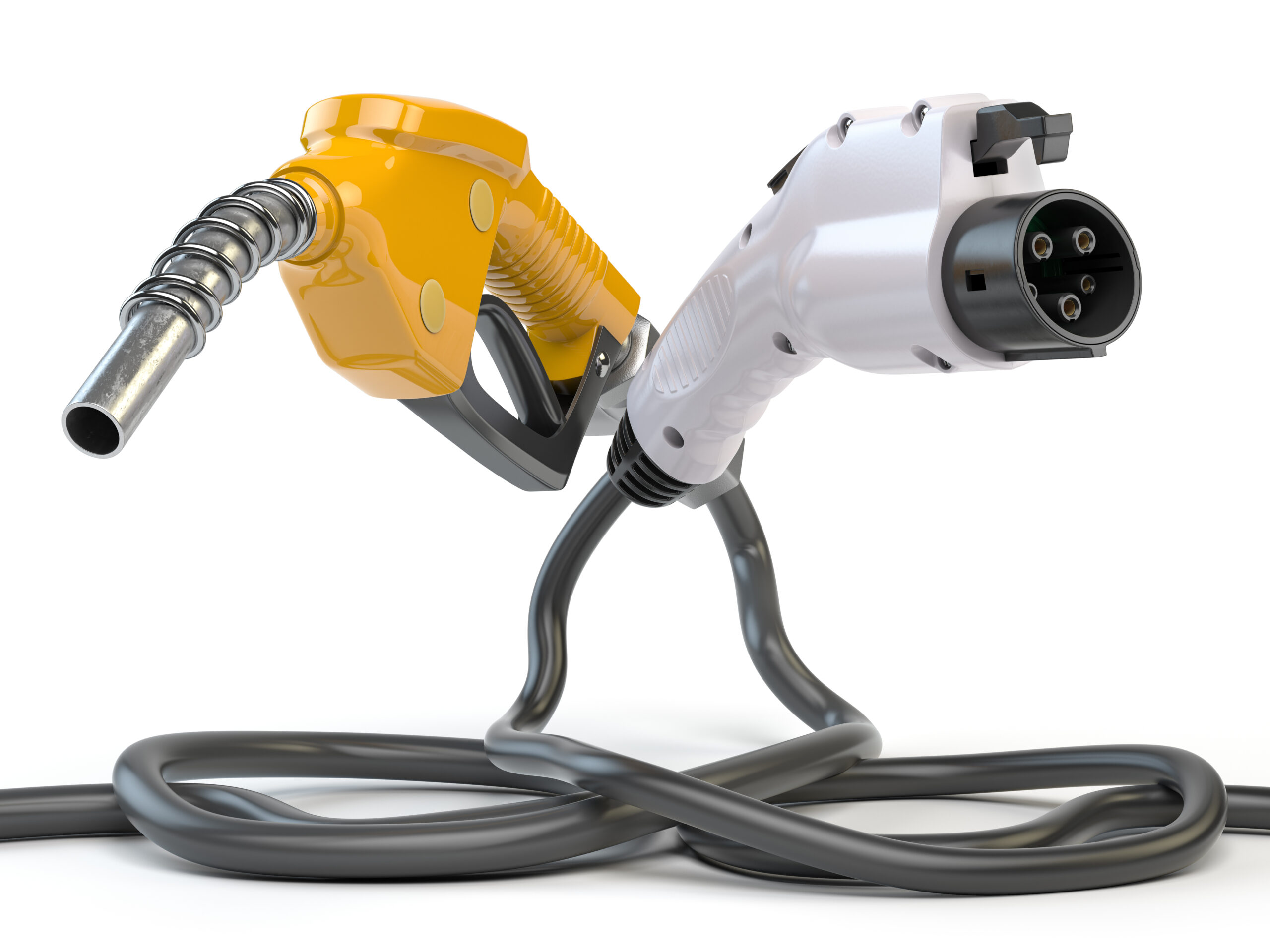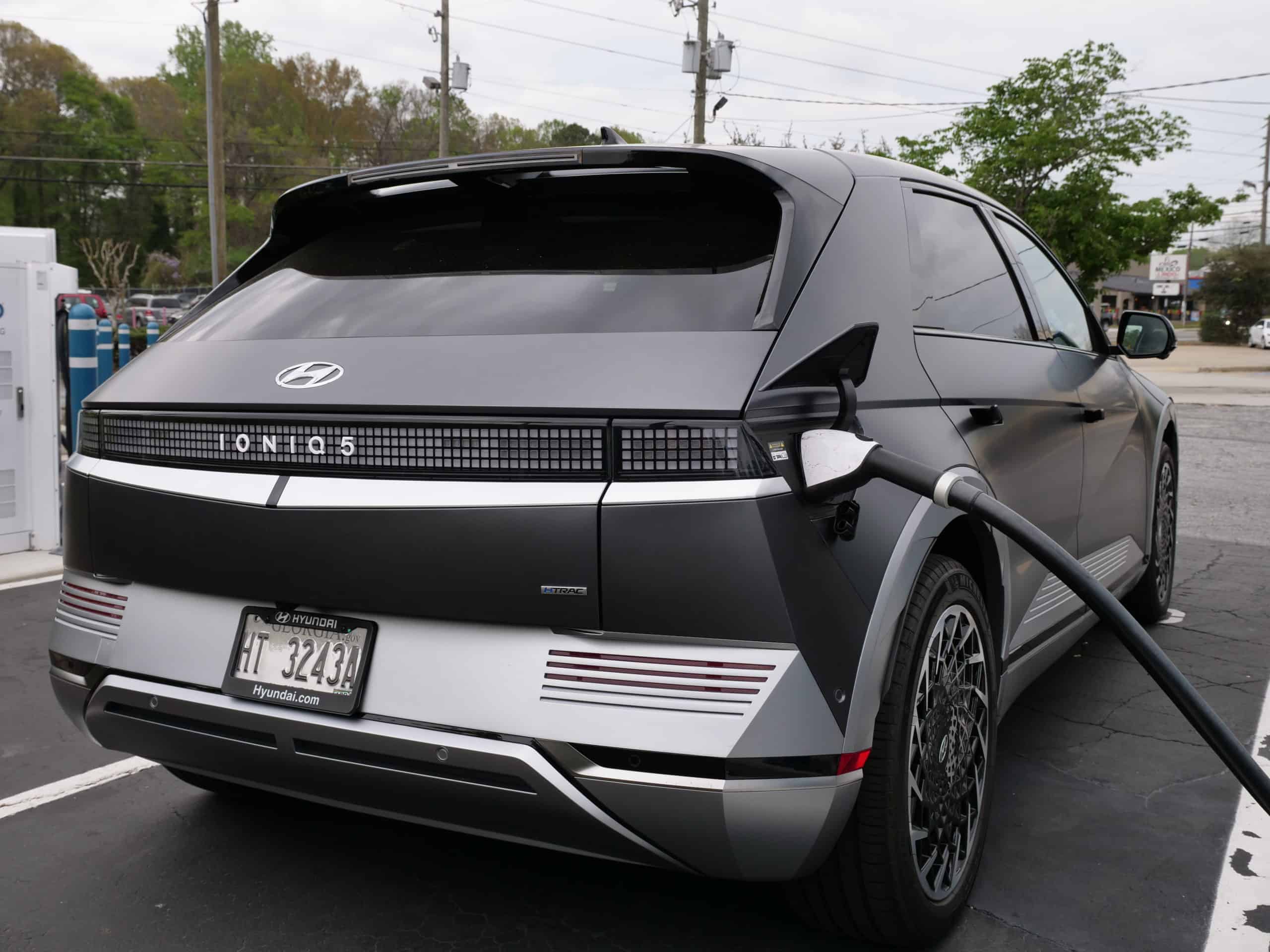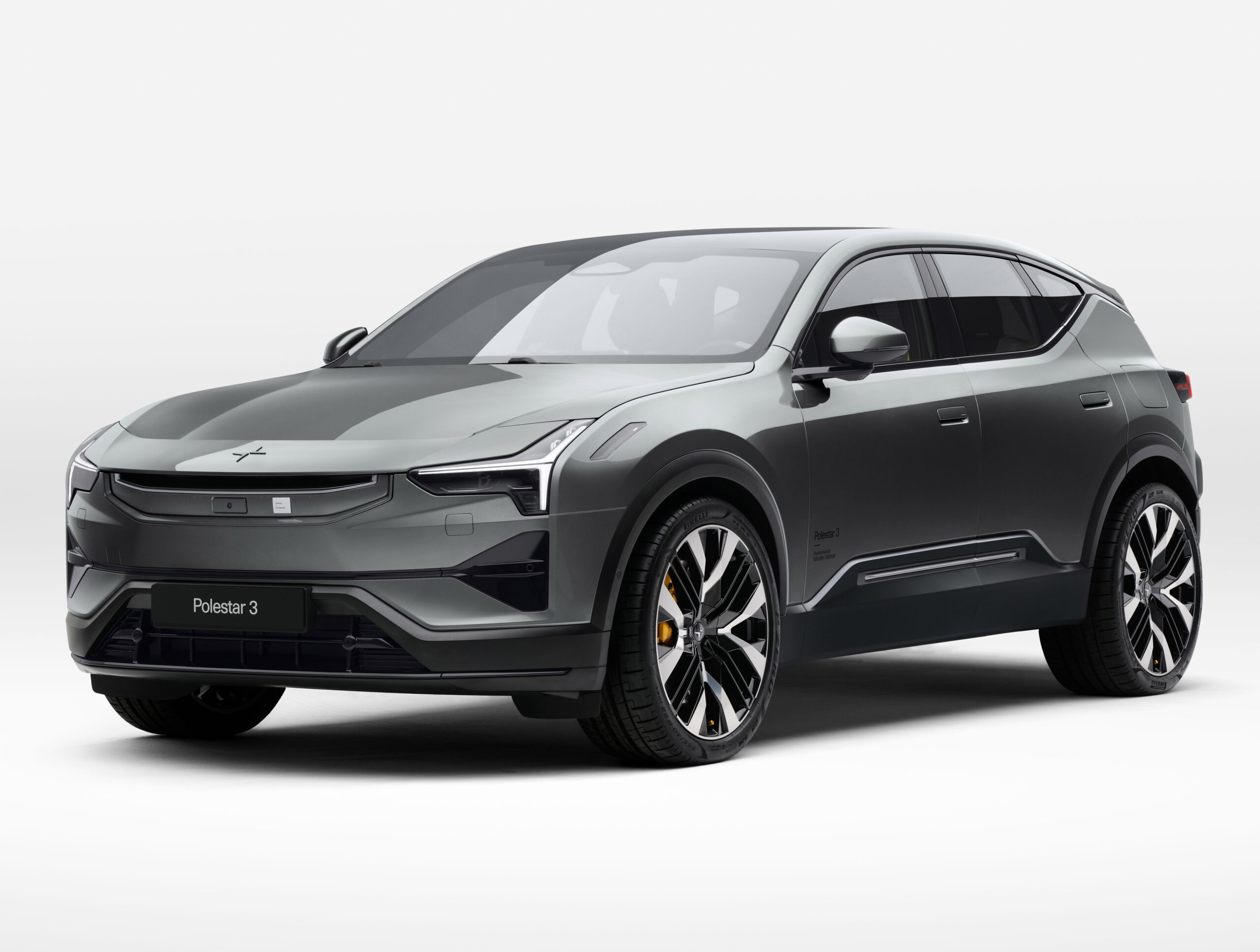

The 2022 Hyundai IONIQ 5 joins a small club of production vehicles that look shockingly similar to their concept/prototypes (good or bad), with this one being inspired by Hyundai’s 2019 ’45’ concept. That list includes the stunningly beautiful Lexus LC, and I believe this car is equally stunning in its design execution. It also rides on the company’s dedicated e-GMP platform with one of the fastest charging times available in a new EV. It is also a deceptively large car that makes the most out of its flexible interior packaging.
Looks are certainly subjective, but I believe the IONIQ 5 has one of the most successful executions of a super-futuristic design on the road today. Not only that, it might be my favorite car design…. ever? Shooting Star Matte paint would not be my first choice for the exterior (also think of the hand-washing you’d have to do), I’d get it in white. The crazy wheels, sharp creases and angles make this look like a larger and much more modern Lancia Delta. Also notice the angled cut line down the doors that connects with the horizontal character line. It is a deceptively large car, with a wheelbase longer than Hyundai’s largest vehicle, the Palisade. Overhangs are minimal, which gives it a smaller hatchback appearance in photos. In person, it is a pretty substantial car that turns heads everywhere it goes.
LEDs are the name of the game on the Limited trim, with rectangular U shapes for DRLs and ‘pixels’ that make up the taillights. The pixel theme carries on throughout the interior and will grace the rest of the IONIQ lineup as well. All trims below the Limited will have black cladding where there is shiny silver cladding seen here.
The cabin is a very open and airy place to be. My tester, rather unfortunately, came with the black vegan leather which exacerbates my least favorite thing about this car – the dashboard. Instead of doing the normal thing, Hyundai gave the two 12-inch displays white bezels. White! Why? They stick out like a sore thumb and make the interior feel unfinished. The steering wheel is a new design for Hyundai and doesn’t feature the brand’s logo. Instead, we have four tiny squares that fall under the ‘pixel’ category. Those four squares (or more appropriately for this situation, dots) actually translate to the letter ‘H’, or Hyundai. Expect more of this on upcoming Ioniq vehicles.

The interior is redeemed by the way the buttons and infotainment function. Unlike Kia’s new two-way panel that switches between audio capacitive touch buttons to climate capacitive touch buttons, this panel always stays the same. There are buttons to take you directly to the seat control screen, though the only way to turn on your seat heaters is ultimately through the screen. I like that there is an easy spot in between the two elements to rest your thumb on so you can more easily interact with the touchscreen. I also like the magnet board on the left side of the steering wheel. It looks like a simple blank panel, but it’s a cool little touch that I haven’t seen before in a car. The driver’s seat has a lounge setting that, when parked, reclines the seat to near-flat and deploys a foot rest. In South Korea, both front seats get this feature. The center console also manually slides forward and backwards, though it is motorized in South Korea. This creates a completely open space on the floor between driver and passenger. You can stretch out your legs or let a furry friend hang out with you up front. All they have left to do is offer a bench seat and make this a six-seater!
The rear seat is also pretty spacious, though my taller friend (well over 6 feet) found head room to be a bit lacking. On Limited trims only you get a massive glass roof with a power-retracting shade. It really brightens things up inside, but does take away some of the available head room. Lower trims don’t get any sunroof of any size, rather unfortunately. The seats can slide forward and backward a couple of inches and recline an average amount. Air vents are on the b-pillars, and there are charge ports at the back of the center console. Two map pockets of the mesh variety are here, as is a fold down armrest with cupholders. Cargo room is not Palisade-sized, but the area of the cargo floor is massive. There’s 27 cubic feet of space which isn’t best in class since the space is compromised by the car’s aggressively-angled tailgate. There is under the floor storage, but no spare tire.
The IONIQ 5 rides on Hyundai Motor Group’s Electric Global Modular Platform, designed around a native 800 volt architecture, unlike the dual-voltage system we find in GM’s new Ultium EVs. Also native to the platform is 1.9 kW of vehicle to load inversion ability delivered either via on-board 120V US-standard outlets or via a J1772 to NEMA 15 receptacle adapter that you plug into the vehicle’s charging port. If you buy your Ioniq 5 in Europe (or other 240V single voltage countries) then you get 3.6 kW of V2L functionality.
Currently, there are two battery sizes to choose from: 58 kWh and 77.4 kWh. The former is only available on the base SE trim and is RWD-only, but it gets you into the IONIQ 5 for about $40k before incentives and puts out 168 horsepower. The larger battery can be had with rear or all-wheel-drive. Getting the bigger battery single motor model gets you 225 horsepower, with the AWD trim adding a 95 HP front motor, bringing the total to 320. The model I was testing was a Limited AWD with a 0-60 mph time which Alex 0-60 tested in California at 4.4 seconds.
Want more power? You have options. Currently the related Genesis GV60 can be had with up to 483 horsepower in “boost” mode, the upcoming EV 6 GT will sport an estimated 580, and the “we all know it’s coming” Ioniq 5 N will likely also be close to 600 ponies.

I was able to test the charging speed of the IONIQ 5 at one of my local (working) 350 kW fast charging stations. The steady peak charge rate in the meat of the 10-80% portion hit 228 kW, which is very impressive, but just shy of Alex’s 240 kW peak in the temperate climes of Northern California. I timed the 10-80% charge, and to my delight it took about as long as Hyundai claims it should: 18 minutes.
More important for home owners is likely to be the onboard 11 kW charger that (when mated with the proper EVSE) can re-charge the commute of the average American (30 miles) in around an hour.
The 2022 Hyundai IONIQ 5 is a very easy car to drive. Steering is light but pretty direct, and at low speeds it does give you more of a minivan/crossover vibe than a sporty hatch like the EV6. Some people might not like that about it, but this is definitely the more passenger-considerate of the two. The ride quality between them is strikingly similar, as expected. It is luxury-car smooth and quiet. The wide 255 mm tires aren’t vocal yet still manage to help you feeling confident in the curves. There are clear differences between Normal, Eco and Sport driving modes, too. Hold the brake and the accelerator in Sport mode and you’re met with lightning quick acceleration once you release the left pedal. It makes me very excited for the upcoming high-performance N variant, because this one is already giggle-inducing. I have not driven a single motor variant with either battery pack, but I imagine the base model with 168 horsepower might feel a little lethargic due to the weight of the car (3,968 pounds). The dual-motor AWD models weigh 4,414 pounds.
An interesting twist with the Ioniq 5’s eco mode is a real reduction in power. All AWD models have a front axle disconnect feature, similar to what we see in RAM pickup trucks. The mechanical disconnect not only cuts power to the front motor, it decreases the parasitic friction losses found in the front differential as well. In Normal mode, the AWD Ioniq 5 connects and disconnects the front motor as needed. Sport mode leaves the front motor connected all the time (reducing highway efficiency in the process) and Eco mode will only use the front motor from 0 to approximately 5 MPH. After that, the front motor is disconnected and power drops to only what the rear motor can deliver. Don’t worry, if front wheel slip is detected, the front axle will re-connect but it’ll take a second or so.

There is some body roll in the corners, but you can still tell there is a heavy battery below you keeping things in check. The car never feels like it’s off the rails or going to topple over on you. People who complain that EVs can’t be fun need to try Hyundai’s regenerative braking system. You can find it on other models like the Kona Electric, but basically it uses steering wheel-mounted paddles to manage the intensity of the regeneration of electricity during braking. The full ‘i-Pedal’ mode enables one-pedal driving, though it can be a bit herky-jerky for passengers. The best way I found to interact with the system was to move between Lvl. 1-3 of intensity when you initiate a long brake towards an intersection, for example. Once you have mastered how that feels, then you can hold the paddle for temporary i-Pedal action when it is time to bring the car to a complete stop. You’ll quickly learn how to brake the car without ever using the pedal, and it is a great way to be engaging with an otherwise digital experience. Otherwise, the brakes felt up to the task of bringing this big little guy to a confident stop.
Prices for the IONIQ 5 start at $39,950 for the single motor rear-wheel drive model, “SE Standard Range”. I would suggest you skip that one unless you really don’t mind the slower acceleration and smaller range. You’ll still get a car with a fantastic design and ultra-fast charging capabilities and the perky instant torque for perfectly acceptable around-town driving. I suggest taking advantage of the $7,500 Federal EV tax credit and shoot for the stars with a rear-wheel drive Limited trim. As long as Hyundai hasn’t sold 200,000 plug-in hybrids and EVs, you’ll be able to snag one for a net price of $44,875. That model will get you the most range (303 miles) and all of the bells and whistles, including highway drive assist, an augmented reality head up display, and a massive panoramic moonroof (with a power shade, somewhat of a commodity these days). You should get the dual motor all-wheel model for $3,900 more if you need all-weather traction and want the fastest accelerating model. Range drops to 256 miles, however. In my opinion, that is plenty of range if this is a car you won’t be taking on long road trips. Charge at home and you’ll never really need to worry about it!
Compared to its platform-mate, the Kia EV6, the IONIQ 5 is just about neck-and-neck. This makes the decision to buy one over the other a subjective decision. Which one looks better to you? How much do you need that extra range? The EV6’s sleeker body will enable that for you, (about 25 miles extra on the highway) but range anxiety is unlikely to be an issue for either model. Compare it to the established player, the Tesla Model Y, and the Ioniq 5 is significantly less expensive. And it still qualifies for the full $7,500 tex credit, unlike the Tesla, Ford, and soon the Toyota competition. The Hyundai has the better interior (despite my qualms), a faster charging time (although a slower charging peak), and a more attractive design. A Ford Mustang Mach-E will ride a bit more like a Tesla, but handling falls behind the Ioniq or the Model Y. If that’s what you’re after, then the IONIQ 5 might not be for you. Again, the N will very likely eliminate all hesitancy that a sporty IONIQ 5 can exist. It is coming, so get ready.
The 2022 Hyundai IONIQ 5 is one of the best options in the electric space right now for any price. It looks like it came from a future that supports attractive designs, has a thoughtful interior with decent practicality, and a range of performance specs that will fit a variety of needs and budgets. Deciding between this and the EV6 will come down mostly to your preference for style and interior functionality. Luckily for you, you cannot go wrong with either one.



